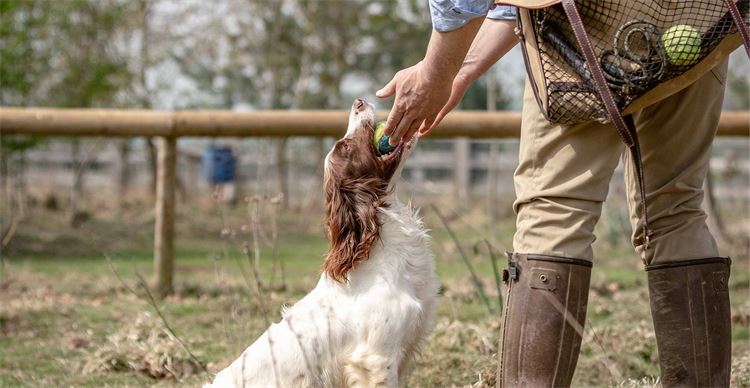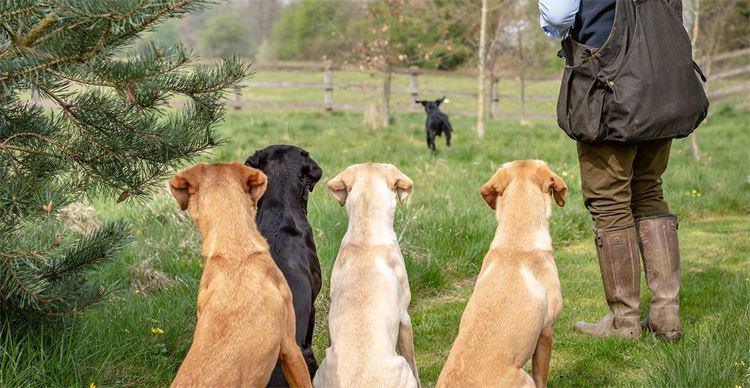I am 44 years old and I got my first spaniel 32 years ago, back in 1987. There have been a lot of developments in training in the intervening years, and many of them have been extremely beneficial.
When I was a young lad with a new spaniel, I read training books and observed the way other people handled their dogs on shoots. There were no DVDs then and this was the only way to learn. But back then they were pretty much all hard-going dogs. The breed lines three decades ago were quite tight, and the end result was a lot of highly driven dogs which were focused on achieving their goals and nothing else.
This sounds okay until you realise what this really meant was there was probably too much emphasis on the dog doing everything of its own volition. Or, in layman’s terms, there was a danger of the dog smashing the place to pieces. Obviously the handler would have had some control, but once the bird was shot it was often down to the dog to do the rest. Compared to nowadays there was minimal directional intervention.
Playing with fire
The positives of this were that we had spaniels that would hunt fearlessly and would retrieve the game quickly. But the negatives were that if there was a lot of game around, dogs would be very hard to control. Once the dog was sent, quite often it would mismark the bird and hunt a large area, wasting time and disturbing birds everywhere. They could be frantic, and there was an element of smash, bang, wallop about the work.
Because there were no soft lines available, people were mating fire with fire and producing a bigger fire. It was common to have a dog that was trying to beat the handler, rather than working with them. As an example, if you were trying to train a dog to quarter within gun range, it would always push on too far. It just wouldn’t have the patience or trainability to stay within range. Like children, all dogs will push the boundaries of course, but I just found they were too hard for my temperament.
Trial and error in the breeding line
About two decades ago we started to see some gradual changes as people started to outcross the breeding lines, because they were searching for something a little softer. The Holy Grail, if you like, was a dog that was more biddable yet retained the drive, strength and pace of the original versions. But the question was always, would it work?
This is trial and error territory. After all, who can ever tell whether a new breeding line venture will work? It might do and it might not, but one thing is for sure: if you don’t try you will never know. You are going so far away from what works to put something new in.
What we did find is that when it did work we produced a dog that was less stubborn and keener on working as a team with the handler.
It’s in your hands
One aspect of the new approach to handling – which I suppose might be obvious but I think it’s important to spell out – is that I don’t use any sort of physical reprimands when training. Of course it’s tempting sometimes, particularly in the most frustrating moments, to resort to this but there is always a better way. The chances are that if the dog has done something you are not happy about, then ultimately the fault lies with the trainer/handler. So it is vital to have the understanding and patience to always remember everything your dog does is a reaction to something you have done.

A vicious circle
There has been tremendous global success for British spaniels in recent years, and they have competed and succeeded all over the world, not least because they are easy and biddable.
But some of the recent dogs which are a result of new breeding efforts are very soft. The problem I have seen is that dogs get passed from pillar to post because the old way of training doesn’t work with them. If you give the softest and most sensitive dog to a novice handler, the result is not always a good one. The novice can be too loud on the whistle and too loud on the directional work, and as a result the dog can easily close down. They can be so sensitive that if you tell them off in the wrong way, all of a sudden the dog clamps up. What happens quite frequently in this situation is the owner loses their patience and sells the dog, but not necessarily to somebody who knows how to deal with the dog any better.
The new handler might see the potential but just doesn’t know how to unlock it either, because they are used to training a harder dog and these methods just don’t work. It then clamps up on them as well.
Psychology is critical
I own a labrador that was the perfect shooting dog. Everybody thought that. It really was perfectly bred for the job in every sense, apart from one. I knew if I pushed the commands too much when it was unsure, without explaining or demonstrating what I wanted, it would ‘pack up’ on me. Then it would be ruined for the rest of that day. We would have to stop and make friends again before I could expect the dog to perform.
But this is all part of the learning curve and has really helped me as a handler. You have to understand the psychology of the dog. Sometimes you have to think outside the box to find other solutions to the problems.
The foundation of an empire
I made up my first champion 15 years ago, and FTCh Steadroc Setlands of Beggarbush became the foundation of my Beggarbush line. This particular springer bitch was the softest and kindest dog I have ever trained. I would probably tell her off (i.e. enter her space and point my finger at her) once or twice a year. There was never any need to raise my voice. Everything was always a huge positive with that dog because it was always about getting a reward. And that reward could be in any format; the food, the retrieve, the hunt, and the flush. Or just working with me in a team.
She got 12 second-place finishes and five firsts in open qualifiers. And the only reason she didn’t win more was because she would never hunt hard enough in a run-off against another dog. She was so soft she didn’t want to push another dog.
Learning from our mistakes
Then I started mating this bitch to start the Beggarbush line, and she was hugely successful. From three litters she produced numerous champions – both internationally and domestically. The breeding lines were tight, and as long as the health elements were fine, I was happy to keep it that way. I was putting quality to quality (or trainability to trainability) and the results spoke for themselves.
Then I thought I would try and out-cross, thinking that if I introduced a harder element to the pedigree the results could be spectacular. I found a dog I liked which was quite old fashioned. It reminded me of the dogs of yesteryear when I saw it and judged it. I wanted to try and put that element of power and aggression back into my lines. Perhaps the results would be almost unbeatable? I went out of my comfort zone to try and produce something better.
However, we had one mating and we only produced one open field trial winner. The rest were nice shooting dogs, but they didn’t have the trainability or the temperament of the previous litters. That mistake has helped me learn. Some people would say it wasn’t a mistake because there was one open field trial winner and the rest were decent shooting dogs, but compared to what she had produced before it wasn’t a success.
Does outcrossing like this work? Not for me on this occasion but I’m sure it could work. However, I probably wouldn’t risk it again.

Reducing turnover
I’m trying to breed lines that I can train and sell and enjoy, but also I’m trying to stop so many dogs going from pillar to post. I have heard of some dogs going through four or even five different homes because the owners can’t handle them. One obvious way of preventing this is teaching people to understand their dogs and adapt their training to their individual psychology. If the owners and handlers are better trained then the dogs will go to fewer homes.
Philosophy on training softer dogs
My way is to see the puppy and use the positive Beggarbush Gundog (BG) Foundations system. This is fun-based positive training and the whole concept is the dog doesn’t even realise it’s being trained. In a nutshell it’s a series of little things done at the right time every day, and in the right scenarios.
The BG Foundations are all about allowing the puppy to have fun, but it really must be fun, and you as the trainer must be the fun. If you can introduce a small amount of training into your daily regime, and always keep your puppy engaged and interested, you will achieve a lot. But as soon as you think your puppy is losing interest then you need to stop for the moment.
Whilst my BG Foundations technique is positive and reward-based, it’s not bribery based. What I am working against is the ‘heel, treat, heel, treat’ approach. I want my dog to work hard for me, do as I ask and the rewards will come in many ways, depending on the temperament of the dog. For some dogs the reward literally comes from performing the task well. For others some verbal praise or patting may be required. And then for some, a little inducement may be required in the form of the odd treat, but certainly not as a matter of course.
I see up to 60 dogs a day and too many of them are being ruined by intensive clicker and treat training, particularly if they are being taught the wrong way by inexperienced trainers with limited success themselves. This is because the dog just sees the handler as a provider of treats and not as a partner in a working relationship. And once a dog has gone too far down this road it’s very hard to cure; in fact, I think the problem can only be managed after that. But I should emphasise these methods can be very good if taught correctly by experienced trainers.
30 years of learning
Over the last three decades I have tried to take a positive out of each training experience and to put them all together to eliminate the negatives. And, for me, the positives from the spaniels of 30 years ago include their power, pace and hunger. My aim has always been to blend these elements with the softer and more trainable aspects of the modern spaniel. I have been very pleased with progress so far but, as with everything, we have to make a few mistakes along the way in order to develop.
It’s about achieving the perfect blend and we are getting closer and closer all the time. The quest continues...